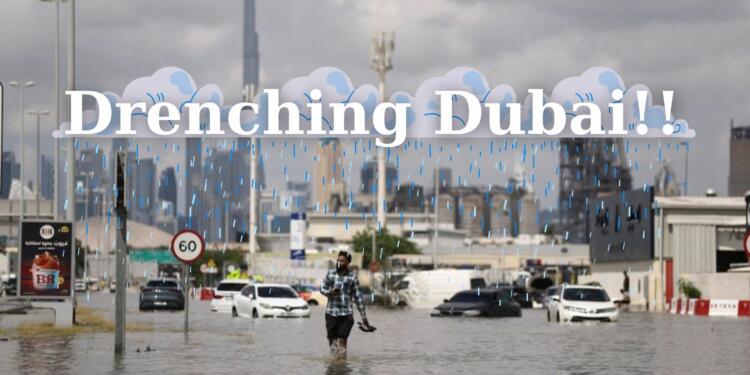Dubai is facing an unprecedented weather. In a historic event, rainfall bombarded the city with water, resulting in widespread flooding of major highways, airports, and metro systems. With a staggering 25 cm of rain recorded within a mere 24-hour period, this deluge is equivalent to nearly two years’ worth of typical rainfall in the region. The magnitude of this event prompts the central question: What factors converged to bring about such extreme weather conditions? Understanding the drivers behind this exceptional rainfall is crucial for both immediate response efforts and long-term resilience planning in the face of increasingly unpredictable weather patterns.
The Role of Natural Weather Patterns
Dubai’s recent deluge of rainfall has been attributed, in part, to a larger storm system making its way through the Arabian Peninsula and the Gulf of Oman. This system, according to experts, has triggered intense thunderstorms, resulting in unprecedented amounts of rain in a short period. Colin McCarthy, a prominent climate scientist, highlights the significance of these storms forming off the warm waters of the Persian Gulf. The convergence of atmospheric conditions, including moisture-laden air and convective processes, has fueled the development of these powerful thunderstorms, leading to the extraordinary rainfall witnessed in Dubai.
Impact of Climate Change
Climate change exacerbates the frequency and intensity of extreme weather events, including heavy rainfall and flooding. Climatologists like Friederike Otto emphasize the role of human-caused climate change in amplifying such events. As global temperatures rise, the atmosphere holds more moisture, increasing the potential for intense precipitation. Otto’s assessment underscores the likelihood that climate change has heightened the severity of the rainfall experienced in Dubai and neighboring regions. The convergence of natural weather patterns with the influence of climate change underscores the complexity of understanding and mitigating the impacts of extreme weather events in the context of a changing climate.
Cloud Seeding Programme in the UAE
In response to water security concerns, the United Arab Emirates (UAE) implemented a cloud seeding program in the early 2000s to augment rainfall in arid regions. This innovative initiative involves the introduction of chemicals and tiny particles, often natural salts like potassium chloride, into the atmosphere to stimulate the formation of raindrops within clouds. By seeding clouds, the aim is to enhance precipitation and increase water resources in water-stressed areas.
The process of cloud seeding typically involves the deployment of seeding planes equipped with equipment to disperse seeding agents into suitable cloud formations. As these agents disperse within the clouds, they serve as nuclei around which water droplets condense and coalesce, eventually growing large enough to fall as rainfall. This technique taps into natural cloud dynamics, amplifying the natural process of precipitation formation.
Specialists and meteorologists have offered insights into the effectiveness and implications of cloud seeding. While proponents argue that cloud seeding has shown promising results in increasing rainfall and mitigating water scarcity, skeptics raise concerns about its long-term environmental impacts and uncertainties regarding its efficacy. Nevertheless, the UAE’s cloud seeding program continues to be a cornerstone of its efforts to address water security challenges in the region.

Collaborative Efforts and Technological Advancements
The UAE’s rain enhancement initiative extends beyond its borders through collaborative research and partnerships with esteemed international institutions. Collaborations with organizations like the National Center for Atmospheric Research (NCAR) in Colorado, USA, Witwatersrand University in South Africa, and NASA have facilitated scientific exchange and technological innovation in weather modification.
In addition to strategic collaborations, the UAE has invested in advanced technological infrastructure for weather monitoring and prediction. The National Center of Meteorology (NCM) has established a comprehensive network of automatic weather stations (AWOS), weather radars, and an upper air station across the country. These tools enable precise monitoring of weather patterns and provide valuable data for weather forecasting and prediction models.
Climate Change’s Impact on Dubai and the UAE
The UAE, including Dubai, faces a myriad of challenges stemming from climate change, with potential long-term consequences looming on the horizon. Rising sea levels pose a significant threat to the UAE’s extensive coastline, where approximately 85% of the population resides. Coastal erosion and inundation could lead to the loss of valuable infrastructure and habitats, exacerbating the vulnerability of coastal communities.
Water scarcity is a pressing issue exacerbated by climate change, as higher temperatures and altered precipitation patterns disrupt water availability. With the UAE’s heavy reliance on desalination for freshwater supply, increased energy demand and environmental concerns arise. Agricultural sectors face mounting challenges due to water scarcity and changing climatic conditions, impacting food security and necessitating innovative adaptation strategies.
Pollution levels are another concern, with climate change potentially exacerbating air and water pollution in urban centers like Dubai. Rising temperatures may intensify the use of air conditioning, leading to increased energy consumption and greenhouse gas emissions. Additionally, carbon-based fuel reliance for power generation contributes to pollution levels, posing health risks to residents.
Implications for Aviation and Transportation
The recent heavy rainfall in Dubai has had immediate and disruptive effects on aviation and transportation infrastructure. Dubai International Airport, one of the world’s busiest hubs, faced significant disruptions as standing water-covered taxiways and runways, leading to flight delays and cancellations. Passengers encountered difficulties accessing terminals amidst flooded roadways, exacerbating travel challenges.
The inundation of major roadways and public transportation systems, including the driverless metro rail system, further compounded transportation disruptions. Motorists struggled to navigate flooded streets, with some vehicles submerged in deep water. The deployment of tanker trucks to pump away excess water highlights the urgent response required to address the impacts of extreme weather events on transportation networks.
Regional Context and Humanitarian Consequences
The effects of heavy rainfall extend beyond Dubai, with neighboring countries like Oman experiencing devastating consequences. Oman witnessed loss of life and property damage due to heavy rains, with reports of fatalities including schoolchildren swept away by floodwaters. The broader regional implications underscore the interconnectedness of extreme weather events and the need for coordinated response efforts.
Humanitarian consequences, including displacement, infrastructure damage, and economic losses, underscore the urgency of addressing the impacts of climate change and extreme weather events. Regional cooperation and proactive measures are essential to enhancing resilience and mitigating the adverse effects of climate variability on vulnerable communities across the Arabian Peninsula.
In conclusion, Dubai’s unprecedented rainfall underscores the complex interplay between natural weather patterns and the impacts of climate change. The event highlights the urgent need for further research, preparedness, and mitigation strategies to address the escalating risks posed by extreme weather events in the region. It is imperative to enhance resilience through proactive measures, including improved infrastructure, sustainable water management practices, and collaborative international efforts. By prioritizing adaptation and mitigation, we can mitigate the adverse effects of climate variability and safeguard the well-being of communities in Dubai and across the Arabian Peninsula.
Also Read: S Jaishankar’s Prophecy: India’s Retort in the Wake of Potential Threats like 26/11































